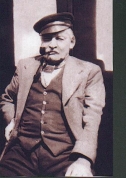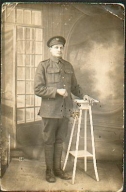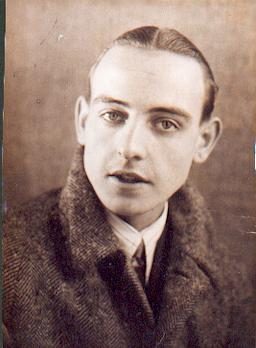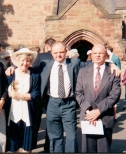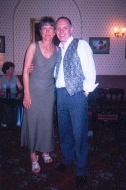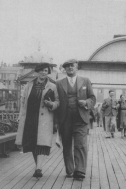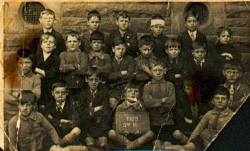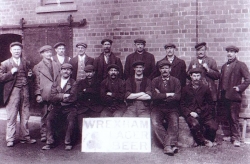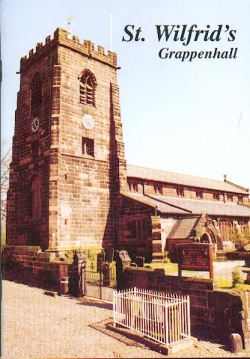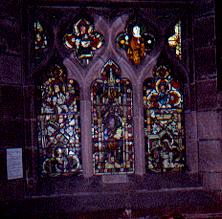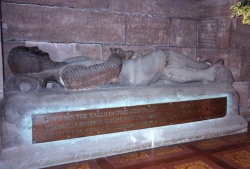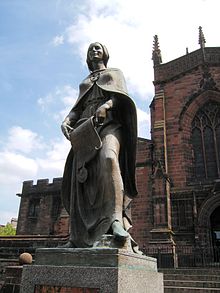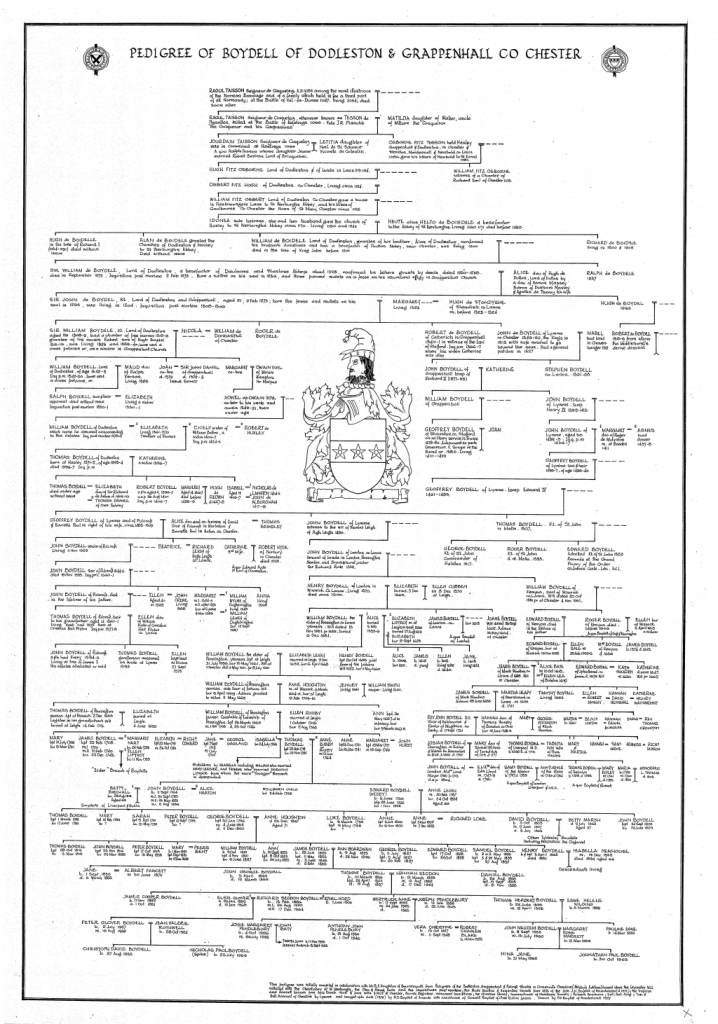Wolverhampton
The Following information was taken from Wikipedia http://en.wikipedia.org/wiki/Wolverhampton
Wolverhampton (Listeni/ˌwʊlvərˈhæmptən/) is a city and metropolitan borough in the West Midlands, England. In the 2011 census, the local government district had population of 249,470.[2] Wolverhampton's urban population at the time of the 2001 census was given as 251,462, and was the second largest component of the West Midlands Urban Area[3] which makes it part of the third largest urban area in the United Kingdom. By this reckoning, it is the 12th largest city in England outside London. For Eurostat purposes, Wolverhampton is a NUTS 3 region (code UKG39). People from Wolverhampton are known as "Wulfrunians".
Historically a part of Staffordshire, and forming part of the metropolitan county of the West Midlands from 1974, the city is commonly recognised as being named after Lady Wulfrun, who founded the town in 985: its name coming from Anglo-Saxon Wulfrūnehēantūn = "Wulfrūn's high or principal enclosure or farm".[4][5][6] Prior to the Norman Conquest, the area's name appears only as variants of Heantune or Hamtun, the prefix Wulfrun or similar appearing in 1070 and thereafter.[5] Alternatively, the city may have earned its original name from Wulfereēantūn = "Wulfhere's high or principal enclosure or farm" after the Mercian King,[7] who tradition tells us established an abbey in 659, though no evidence of an abbey has been found.[8]
The variation Wolveren Hampton is seen in medieval records, eg in 1381.[9]
The city grew initially as a market town with specialism within the woollen trade. During and after the Industrial Revolution, the city became a major industrial centre, with mining (mostly coal, limestone and iron ore) as well as production of steel, japanning, locks, motorcycles and cars – including the first vehicle to hold the Land speed record at over 200 mph. Today, the major industries within the city are both engineering based (including a large aerospace industry) and within the service sector.[10]
History
A local tradition states that King Wulfhere of Mercia founded an abbey of St Mary at Wolverhampton in 659.[11]
Wolverhampton is recorded as being the site of a decisive battle between the unified Mercian Angles and West Saxons against the raiding Danes in 910, although sources are unclear as to whether the battle itself took place in Wednesfield or Tettenhall.[12] The Mercians and West Saxons claimed a decisive victory and the field of Woden is recognised by numerous place names in Wednesfield.[13][14]
Statue of Lady Wulfrun on western side of St. Peter's Collegiate Church. (see below photo right)
In 985, King Ethelred the Unready granted lands at a place referred to as Heantun to Lady Wulfrun by royal charter,[15] and hence founding the settlement.
In 994, a monastery was consecrated in Wolverhampton for which Wulfrun granted land at Upper Arley in Worcestershire, Bilston, Willenhall, Wednesfield, Pelsall, Ogley Hay near Brownhills, Hilton near Wall, Hatherton, Kinvaston, Hilton near Wolverhampton, and Featherstone.[15] This became the site for the current St. Peter's Church.[16] A statue of Lady Wulfrun, sculpted by Sir Charles Wheeler, can be seen on the stairs outside the church.[15]
In 1179, there is mention of a market held in the town, and in 1204 it had come to the attention of King John that the town did not possess a Royal Charter for holding a market. This charter for a weekly market held on a Wednesday was eventually granted on 4 February 1258 by Henry III.[16]
It is held that in the 14th and 15th centuries that Wolverhampton was one of the "staple towns" of the woollen trade,[16] which today can be seen by the inclusion of a woolpack on the city's coat of arms,[17] and by the many small streets, especially in the city centre, called "Fold" (examples being Blossom's Fold, Farmers Fold, Townwell Fold and Victoria Fold), as well as Woolpack Street and Woolpack Alley.[16]
In 1512, Sir Stephen Jenyns, a former Lord Mayor of London and a twice Master of the Worshipful Company of Merchant Taylors, who was born in the city, founded Wolverhampton Grammar School, one of the oldest active schools in Britain.[18]
From the 16th century onwards, Wolverhampton became home to a number of metal industries including lock and key making and iron and brass working.
Wolverhampton suffered two Great Fires: the first in April 1590, and the second in September 1696. Both fires started in today's Salop Street. The first fire lasted for five days and left nearly 700 people homeless, whilst the second destroyed 60 homes in the first five hours. This second fire led to the purchase of the first fire engine within the city in September 1703.[16]
On 27 January 1606,[19] two farmers, Thomas Smart and John Holyhead of Rowley Regis, were executed on High Green, now Queen Square, for sheltering two of the Gunpowder Plotters, Robert Wintour and Stephen Littleton,[20] who had fled to the Midlands. The pair played no part in the original plot but nevertheless suffered a traitor's death of being hanged, drawn and quartered on butcher's blocks set up in the square a few days before the execution of Guy Fawkes and several other plotters in London.[16]
There is also evidence that Wolverhampton may have been the location of the first working Newcomen Steam Engine in 1712.[21]
19th century
The young Princess Alexandrina Victoria of Kent (later Queen Victoria) is known to have visited Wolverhampton in the 1830s and described it as "a large and dirty town" but one which received her "with great friendliness and pleasure".
In Victorian times, Wolverhampton grew to be a wealthy town mainly due to the huge amount of industry that occurred as a result of the abundance of coal and iron deposits in the area. The remains of this wealth can be seen in local houses such as Wightwick Manor and The Mount (both built for the Mander family, prominent varnish and paint manufacturers), and Tettenhall Towers. Many other houses of similar stature were built only to be demolished in the 1960s and 1970s.
Statue of Prince Albert, Queen Square
Wolverhampton gained its first parliamentary representation as part of the Reform Act 1832, when it was one of 22 large towns that were allocated two members of parliament. It was incorporated as a municipal borough on 15 March 1848 under the Municipal Corporations Act 1835 before becoming a County Borough in 1889.[22]
The railways reached Wolverhampton in 1837, with the first station located at Wednesfield Heath, now Heath Town on the Grand Junction Railway.[23] This station was demolished in 1965, but the area exists as a nature reserve just off Powell Street.[24] Wolverhampton railway works was established in 1849 for the Shrewsbury and Birmingham Railway and became the Northern Division workshop of the Great Western Railway in 1854.[25]
In the 19th century the city saw much immigration from Wales and Ireland, following the Irish Potato Famine.
In 1866, a statue was erected in memory of Prince Albert the Prince Consort, the unveiling of which brought Queen Victoria to Wolverhampton.[26] The unveiling of the statue was the first public appearance Queen Victoria had made since the funeral of her husband. A 40-foot (12 m) tall archway made of coal was constructed for the visit. The Queen was so pleased with the statue that she knighted the then-mayor, an industrialist named John Morris. Market Square, originally named High Green, was renamed Queen Square in honour of the visit. The statue replaced a Russian cannon captured from Sevastopol during the Crimean War in 1855,[22] and remains standing in Queen Square.
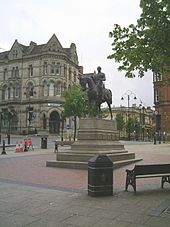
Wolverhampton was represented politically in Victorian times by the Liberal MP Charles Pelham Villiers, a noted free trade supporter, who was also the longest serving MP in parliamentary history. Lord Wolverhampton, Henry Hartley Fowler was MP for Wolverhampton at the turn of the century.
Since 1900
Wolverhampton had a prolific bicycle industry from 1868 to 1975, during which time a total of more than 200 bicycle manufacturing companies existed there, but today none exist at all. These manufacturers included Viking, Marston, Sunbeam, Star, Wulfruna and Rudge.[27] The last volume manufacturers of bicycles left Wolverhampton during the 1960s and 1970s - the largest and best-known of which was Viking Cycles Ltd,[28] whose team dominated the UK racing scene in the 1950s (Viking's production of hand-built lightweight racing and juvenile bicycles exceeded 20,000 units in 1965). Closures of other smaller cycle makers followed during the 1980s including such well-known hand-builders as Percy Stallard (the former professional cyclist) and Jack Hateley.[29]
Wolverhampton High Level station (the current main railway station) opened in 1852, but the original station was demolished in 1965 and then rebuilt.[30] Wolverhampton Low Level station opened on the Great Western Railway in 1855. The site of the Low Level station, which closed to passengers in 1972 and completely in 1981, is currently undergoing redevelopment.[31]
In 1918, David Lloyd George, the British Prime Minister, announced he was calling a General Election at "The Mount" in Tettenhall Wood.[32] Lloyd George also made his "Homes fit for heroes" speech at Wolverhampton Grand Theatre in the same year.[33] It was on the idea of "Homes fit for heroes" that Lloyd George was to fight the 1918 "Coupon" General Election.
Mass council housing development in Wolverhampton, to rehouse families from slum housing, began after the end of the Great War, with new estates at Parkfields (near the border with Coseley) and Birches Barn (near Bantock Park in the west of Wolverhampton) being built, giving the city some 550 new council houses by 1923. The first large council housing development in Wolverhampton was the Low Hill estate to the north-east of the city, which consisted of more than 2,000 new council houses by 1927 and was one of the largest housing estates in Britain at the time.[34] Mass council housing development in Wolverhampton continued into the 1930s, mostly in the north of the city in the Oxley and Wobaston areas and on the new Scotlands Estate in the north-east. However, council house building halted in 1940 following the outbreak of World War II in September the previous year.[35]
Wolverhampton St George's (in the city centre) is now the northern terminus for the Midland Metro light rail system. Wolverhampton was one of the few towns to operate surface contact trams and the only town to use the Lorain Surface Contact System.[36] Trolleybuses appeared in 1923 and in 1930 for a brief period, the Wolverhampton trolleybus system was the world's largest trolleybus system.[37] The last Wolverhampton trolleybus ran in 1967, just as the railway line through the High Level station was converted to electric operation.
Location of the UK's first set of traffic lights at Princes Square: the poles are painted with black and white bands as they were originally. England's first automatic traffic lights could be seen in Princes Square, Wolverhampton in 1927.[38] The modern traffic lights at this location have the traditional striped poles to commemorate this fact. Princes Square was also the location of the United Kingdom's first pedestrian safety barriers, which were erected in 1934.[39]
On 2 November 1927, the A4123 New Road was opened by the then-Prince of Wales (later Edward VIII of the United Kingdom).[40] linking the city with Birmingham. The New Road was designed as an unemployment relief project[41] and was the United Kingdom's first purpose-built intercity highway of the twentieth century.[42]
Sir Geoffrey Le Mesurier Mander, a member of the Mander family, was Liberal MP for Wolverhampton East from 1929 to 1945, distinguished for his stance against Appeasement and as a supporter of the League of Nations; known as "the last of the Midland radicals".
More recent members have included the Conservative mavericks Enoch Powell and Nicholas Budgen. Powell was a member of Edward Heath's Tory shadow cabinet from 1964, until he was dismissed in April 1968 following his controversial Rivers of Blood speech in which he warned of massive civil unrest if mass immigration of black and Asian commonwealth inhabitants continued.
In 2005, former Bilston councillor and MP for Wolverhampton South East, Dennis Turner entered the House of Lords as Lord Bilston.
After the end of World War II in 1945, the council erected 400 prefabricated bungalows across Wolverhampton, and built its first permanent postwar houses at the Underhill Estate near Bushbury in the late 1940s.[43]
The 1950s saw many new houses and flats built across Wolverhampton as the rehousing programme from the slums continued, as well as the local council agreeing deals with neighbouring authorities Wednesfield Urban District and Seisdon Rural District which saw families relocated to new estates in those areas.[44]
The 1960s saw the rehousing programme continue, with multi-storey blocks being built on a large scale across Wolverhampton at locations including Blakenhall, Whitmore Reans and Chetton Green. The later part of the decade saw the Heath Town district almost completely redeveloped with multi-story flats and maisonette blocks.[45]
By 1975, by which time Wolverhampton had also taken in the majority of the former districts of Bilston, Wednesfield and parts of Willenhall, Sedgley and Coseley, almost a third of Wolverhampton's population lived in council housing, but since that date social housing has been built on a minimal scale in the area, and some of the 1919–1975 developments have since been demolished.[46]
Large numbers of black and Asian immigrants had settled in Wolverhampton in the 1940s, 1950s and 1960s. Wolverhampton is home to a large proportion of the Sikh community, who settled there during the period (1935–1975) from the Indian state of Punjab. Today, the Sikh community in Wolverhampton is roughly 7% of the city's population.
In 1974, as a result of local government reorganisation, Wolverhampton became a metropolitan borough.
The United Kingdom government announced on 18 December 2000 that Wolverhampton would be granted city status, making it one of three "Millennium Cities",[47] an honour that had been unsuccessfully applied for in 1953, 1966, 1977,[48] 1985[49] and 1992.[48]
Wolverhampton also made an unsuccessful application for a Lord Mayor in 2002.[48]
Many of the city centre's buildings date from the early 20th century and before, the oldest buildings being St Peter's Church (which was built in the 13th century but has been largely extended and refurbished since the 15th century, situated on Lichfield Street)[50] and a framed timber 17th-century building on Victoria Street which is now one of just two remaining in the area which was heavily populated by them until the turn of the 20th century. This building was originally a residential property, but later became the Hand Inn public house. It was completely restored in 1981 after a two-year refurbishment project and has been used by various businesses since then – currently as a second hand book shop.[51]
In 1960, plans were announced to build a Ring Road around the centre of Wolverhampton. By the end of the 1960s, more than half of the Ring Road had been completed, stretching from Snow Hill to Stafford Street (via Penn Road, Chapel Ash and Waterloo Road), followed a few years later by a section between Snow Hill and Bilston Street. However, the final section between Bilston Street and Stafford Street (via Wednesfield Road) was not completed until 1986.
The centre of Wolverhampton has been altered radically since the mid-1960s; with the Mander Centre (plans for which were unveiled on 15 April 1965)[52] being opened in two phases, the first in 1968 and the second in 1971. Several refurbishments have taken place since. The Wulfrun Centre, an open shopping area, was opened alongside the Mander Centre's first phase in 1968, but has been undercover since a roof was added in the late 1990s.[53]
Central Wolverhampton police station was built just south of the city centre on Birmingham Road during the 1960s, but operations there were cut back in the early 1990s when a new larger police station was built on Bilston Street on land which became vacant a decade earlier on the demolition of a factory. This was officially opened by Diana, Princess of Wales, on 31 July 1992.[54]
The city centre had several cinemas during the 20th century, the last of these was the ABC Cinema (formerly the Savoy) on the corner of Garrick Street and Bilston Street, which closed on 17 October 1991 after 54 years. It has since been converted into a nightclub, with part of the site being converted into the offices of a recruitment agency in 2005.[55]
A modern landmark in the city centre is the Crown Court on Bilston Street, which opened in 1990 as the town's first purpose built crown court.[56]
Many department store chains including Beatties, Marks and Spencer, British Homes Stores and Next have stores in the centre of Wolverhampton. Rackhams had a store on Snow Hill for some 25 years until 1992. This building was then divided between a Netto supermarket and the local archives service but by 2006 its future was under threat as part of the proposed Summer Row retail development. This led to the closure of the Netto supermarket in June 2007 and the closure of the archives service in October 2008. However, the Summer Row project has since fallen through and the building remains dormant.
The city's name is often abbreviated to "Wolvo" or "W'ton".[57] or "Wolves".[58][59]
Art and culture
From the 18th century, Wolverhampton was well known for production of the japanned ware and steel jewellery. The renowned 18th- and 19th-century artists Joseph Barney (1753–1832), Edward Bird (1772–1819), George Wallis (1811–1891) were all born in Wolverhampton and initially trained as japanned ware painters.
The School of Practical Art was opened in the 1850s and eventually became a close associate of the Art Gallery. Among its students and teachers were Robert Jackson Emerson (1878–1944), Sir Charles Wheeler (Emerson's most famous pupil and the sculptor of the fountains in Trafalgar Square), Sara Page who established her studio in Paris, and many other artists and sculptors recognised locally and nationally.
Wolverhampton Art Gallery was established in 1884, whilst Wolverhampton Grand Theatre was opened in 1894.
There is a Creative Industries Quarter in Wolverhampton, just off Broad Street. From the newly opened Slade Rooms, to the art house cinema the Light House Media Centre and the Arena Theatre which is part of the University of Wolverhampton.
In 1970 the College of Art, at that time called Wolverhampton Polytechnic, later changed its status and name under P.M. John Major's administration to University of Wolverhampton was erected. It is ten floor tall and has witnessed thousands of famous lectures, brilliant minds, highly professional tutors and professors and very talented aspiring art students. Although most famous for its glass studio teachings, it also instructs Fine Art, Ceramics, Sculpture, Graphic Design, Film, Drama... It serves thousands of art students and has a long tradition in studio arts (artists who are mainly self-employed in their own studios).
Additionally, Wolverhampton has a strong history in the ornate cast iron safe painting industry from the Victorian era. Numerous companies, such as Chubb Lock and Safe Company, hired, taught and expanded their artistic status to international reputation, whereby a safe became truly a work of art with fine script and hand-painted designs, highly collectible today. Even in the USA, one can find their preserved masterpieces to this day. The building has been converted into a National Historic Registered Landmark Treasure in 1992, which now houses a cinema, art galleries, nightclub, business offices and a beautiful large stained glass rotunda in its foyer. It is among the few canal street factories so well known in the "Black Country" that has been preserved.
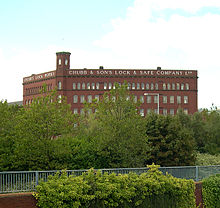
Exhibitions
As its wealth and influence grew, Wolverhampton both took part in notable exhibitions and hosted them. The Great Exhibition of 1851, at The Crystal Palace, had examples of locks, japanned ware, enamel ware and papier-mâché products all manufactured in Wolverhampton.[60]
Following successful exhibitions at Mechanics' Institutes in Manchester and many northern towns, Wolverhampton held an exhibition that was the brain child of George Wallis, an artist employed by the firm of Ryton and Walton. The exhibition was held in the Mechanics' Institute in Queen Street and showed both fine art and furniture, decorated trays, as well as a variety of ironwork, locks and steel toys.[61]
On 11 May 1869 The Earl Granville opened the Exhibition of Staffordshire Arts and Industry in a temporary building in the grounds of Molineux House.[61]
The largest and most ambitious exhibition was the Arts and Industrial Exhibition which took place in 1902. Although housing only one international pavilion, from Canada, the scope and scale of the exhibition mirrored all the advances in other exhibitions of its time. The exhibition site featured several halls housing machinery, industrial products, a concert hall, two bandstands, a restaurant, and a fun fair with thrill rides and a water chute. Its opening, by the Duke of Connaught, was received with hopeful enthusiasm, unfortunately not matched by the weather, which contributed to a £30,000 loss, equivalent to nearly £2M at today's value.[61][62]
Geography
Wolverhampton lies northwest of its larger near-neighbour Birmingham, and forms the second largest part of the West Midlands conurbation.[63] To the north and west lies the Staffordshire and Shropshire countryside.
Wolverhampton
Climate chart (explanation)
J F M A M J J A S O N D
Average max. and min. temperatures in °C
Precipitation totals in mm
Source: "Averages 1971–2000". Met Office.
[show]Imperial conversion
Wolverhampton city centre falls outside of the area traditionally known as the Black Country, although some districts such as Bilston and Heath Town and the Willenhall side of Wolverhampton fall within the Black Country coalfields, leading to confusion as to whether the entire city falls within the region.
Modern usage has tended towards using the term to refer to the western part of the West Midlands county, excluding Birmingham, Solihull and Coventry. Examples would be UK Government regional bodies such as the Black Country Development Corporation, under whose remit the city fell.
The city lies upon the Midlands Plateau at approximately 120 m (394 ft) above sea level, and is the highest city centre in the UK.[64] There are no major rivers within the city, although the River Penk and River Tame (tributaries of the River Trent) rise in the city, as does Smestow Brook, a tributary of the River Stour, and thence the River Severn. This means that the city lies astride the main east-west watershed of England.
The geology of the city is complex, with a combination of Triassic and Carboniferous geology; specifically Bunter and Keuper sandstone, and Upper and Middle Coal measures. There is also an area of dolerite intrusions.[65]
Climate
Wolverhampton's climate is oceanic (Köppen Cfb) and therefore quite temperate with average maximum temperatures in July being around 21 °C (70 °F) with the maximum daytime temperature in January being around 6.5 °C (43.7 °F).
The Met Office's nearest observation station is at Penkridge, about 11 miles (18 km) north of the city.
Government
The vast majority of Wolverhampton is governed locally by Wolverhampton City Council, although some smaller parts of the urban area are governed by South Staffordshire District Council.
The area administered by the City Council is represented in the national United Kingdom parliament by three MPs representing Wolverhampton South West, Wolverhampton South East and Wolverhampton North East constituencies, with the areas administered by South Staffordshire District Council being represented by South Staffordshire constituency. The entire city is part of the West Midlands constituency of the European Parliament.
Wolverhampton City Council is a unitary authority, meaning that it is an all-purpose local council. South Staffordshire District Council is a two-tier authority, with some services provided by Staffordshire County Council.
Civic history
Wolverhampton in 1921
The old Town Hall (magistrates court)
Wolverhampton gained the beginnings of modern local government in 1777, when the Wolverhampton Improvement Act was passed by Parliament. This allowed for the establishment of 125 Town Commissioners who undertook a variety of local improvement work such as punishing bear baiting, improving drainage, widening streets and by the end of the century street lighting had been provided at every street corner and over the doorway of every inn, and water supply had been improved by the sinking of ten new wells and the provision of a great water tank in the market place. Policing had been improved with the appointment of ten watchmen and attempts were also made to regulate the markets and inspect hazardous food.[4][67]
Wolverhampton parliamentary borough was created by the Reform Act 1832, which included areas currently located with the Metropolitan Boroughs of Dudley, Walsall and Sandwell such as Wren's Nest, New Invention and Sedgley. It was one of 22 large towns that returned two members of parliament. Under the Redistribution of Seats Act 1885, the original borough was replaced by three new single-member constituencies: Wolverhampton East, Wolverhampton South and Wolverhampton West.[68]
In 1837, Wolverhampton Borough Police was formed. It was disestablished in 1966, and the larger West Midlands Constabulary, which covered not only Wolverhampton but the County Boroughs of Walsall, Dudley, West Bromwich and Warley took over its duties and was headquartered in the city. This force was then replaced in 1974 with the West Midlands Police.[69]
Wolverhampton was incorporated as a municipal borough in 1849 under the Municipal Corporations Act 1835.[70] The town was then made a County Borough in 1889 under the Local Government Act 1888.[70]
In 1933, the boundaries of the borough expanded, taking in areas from Cannock Rural District and Seisdon Rural District, with very little of the surrounding urban area being affected,[71] with only Heath Town Urban District being abolished.
The bulk of the urban districts of Bilston (a borough itself after 1933), Tettenhall and Wednesfield were added to the borough in 1966, along with the northern section of the urban district of Coseley and parts from the north of Sedgley and the west of Willenhall. The vast majority of these areas were traditionally part of the Parish of Wolverhampton, and were part of the original Parliamentary Borough.[71]
Wolverhampton was one of only two County Boroughs (the other being Liverpool) to have no changes made to the boundary during the 1974 reorganisation of local government, the borough already having a population larger than the 250,000 required for education authorities. This contrasted with both the Redcliffe-Maud Report, and the initial White Paper for the 1974 reforms[72] where large areas of the present South Staffordshire district were to be added to the borough. During the 1974 reforms it was placed within the West Midlands Metropolitan County.
Wolverhampton was also a Royal Peculiar covering a large area.[73]
Wolverhampton City Council
Main article: Wolverhampton City Council
See also: List of Mayors of Wolverhampton
The council offices are in the Civic Centre, which is located in St. Peter's Square in the city centre.[74] The city council's motto is "Out of darkness cometh light".[75]
The Labour Party currently control the council and have been in majority on the council since 1974, with the exceptions of 1978–1979, 1987, 1992–1994 and 2008–2010.[76] The Labour party won 17 out of 20 council seats that were up for election in 2012.
Liberal Democrat Councillor Michael Heap is Mayor of Wolverhampton for 2014–15.[77]
Freemen of Wolverhampton
Below is a list of people granted the title 'Freeman of Wolverhampton':[80][81]
Right Honourable Henry Hartley Fowler, MP, 11 February 1892
Right Honourable Charles Pelham Villiers MP, 11 May 1897
Sir Charles Tertius Mander, Bt, 24 May 1897
Sir Joseph Cockfield Dimsdale, MP, 29 July 1902
Sir Alfred Hickman, MP, 29 July 1902
Alderman William Highfield Jones, 29 July 1902
Sir George Hayter Chubb, 14 October 1909
Alderman John Marston, 14 October 1909
Alderman Joseph Jones, 14 August 1912
Right Honourable David Lloyd George MP, 23 November 1918
Field Marshal Earl Haig of Bemersyde, 16 October 1919
Alderman Albert Baldwin Bantock, 9 November 1926
Alderman Levi Johnson, 9 November 1926
Alderman Thomas William Dickinson, 18 July 1938
Alderman Thomas Austin Henn, 7 October 1943
Alderman Alan Davies, 29 October 1945
Sir Charles Arthur Mander, 29 October 1945
Joseph Harold Sheldon (1920–1964), 24 March 1958. Pediatrician, see Freeman–Sheldon syndrome
Sir Charles Wheeler, 24 March 1958
Denise Lewis OBE, 13 December 2000
Sir Jack Hayward, OBE, 9 July 2003
Veterans of the Princess Irene Brigade who were members of
the Dutch Army stationed at Wrottesley Park during
World War II, 19 August 2006
Dennis Turner, Baron Bilston, The Lord Bilston, 20 December 2006
Hugh Porter, MBE, 17 December 2008
Rachael Heyhoe Flint, Baroness Heyhoe Flint, OBE, DL, 3 November 2010
Demographics
Wolverhampton Compared
2001 UK Census Wolverhampton (urban) Wolverhampton (borough) West Midlands conurbation England
Total population 251,462 236,582 2,284,093 49,138,831
White 78.9% 77.8% 79.6% 90.9%
Asian 13.6% 14.3% 13.5% 4.6%
Black 4.4% 4.6% 3.9% 2.3%
Source: Office for National Statistics[82][83]
The 2001 Census gives the Wolverhampton Urban Subdivision as the second largest in the West Midlands conurbation. The figure given for Wolverhampton is 251,462 which also includes areas outside the borough (236,583). By this reckoning it is the 12th largest city in England outside London.
Wolverhampton has a relatively old population, with the proportion of the population aged 60 and over being larger than the proportion of children aged 15 or under. The proportion of young people in the city has decreased between the 1991 Census and the 2001 Census by 7.4%, compared with an England and Wales average increase of 1.7%. The proportion of females within the city (51%) is slightly higher than that of males (49%).
Of adults aged over 16, 31.3% were single, 43.4% were married for the first time, 7.7% divorced and 9.6% were widowed.[84]
Wolverhampton has a White British population of 78.9%, with 22.2% of residents classifying themselves as non-white in the 2001 Census, with the largest non-white category being Indian at 12.3%, which compares with a West Midlands average of 6.2% and an England and Wales average of 2.1%. Wolverhampton had a significant Asian population who mainly reside in Penn, Farndale and Whitmore Reans areas of the city. It has a high black population who mainly reside in the Heath Town and Whitmore Reans areas of the city. The city is well multicultural and racial tensions and prejudices are amongst the lowest in the country.
Based upon the 2001 census, Wolverhampton has a Christian population of 67.4% and non-Christian religions of 13.6% of people, compared with 5.5% for England and Wales. Wolverhampton has the fourth largest Sikh community in England and Wales. Sikhs accounting for 7.6% of Wolverhampton's population in 2001. Wolverhampton's Sikh Population rose to 9.1% in the 2011 census. The number of Hindus is also higher than the England and Wales average (Wolverhampton 3.9%, England and Wales 1.1%), while the proportion of people following Judaism and Islam was below the average for England and Wales. The figure for Buddhism is in line with the England and Wales average. The 2009 British Social Attitudes Survey, which covers Great Britain but not Northern Ireland, indicated that over 50% of the population would self classify as not religious at all and this should be reflected in the current general Wolverhampton population.
Religion within Wolverhampton
2001 UK Census Wolverhampton (urban) Wolverhampton (borough) West Midlands conurbation England
Total population 251,462 236,582 2,284,093 49,138,831
Christian 67.4% 66.5% 67.0% 71.7%
Sikh 7.2% 7.6% 3.4% 0.6%
Hindu 3.7% 3.9% 1.8% 1.1%
Muslim 1.6% 1.7% 7.9% 3.0%
No religion 11.3% 11.3% 11.5% 14.8%
Not stated 8.2% 8.4% 7.8% 7.7%
Source: Office for National Statistics[85][86]
According to the 2001 Census, 62.2% of the population of the city between the ages of 16 and 75 are considered to be economically active, with 37.5% holding full-time employment, 11.3% part-time employment, 5.4% self-employed and 2.6% being full-time students with other employment.
Of those who are economically inactive, 14.4% were retired, 7.1% were looking after homes or families, whilst 5.1% were full-time students without other employment.[87]
Degree-level qualifications (or above) were held by 13.6% of the population (compared with 19.8% in England and Wales), while 40.7% possessed no qualifications (compared with 29.1% across England and Wales).[88]
Wolverhampton is within the top 11% of local council areas in England and Wales (excluding London Boroughs) for public transport use for travelling to work at 16% of the total. 63% used private transport, either as a driver or passenger, 13% cycled or travelled on foot, whilst 8% worked from home.[89]
Car ownership is lower than the average for England and Wales with 35.2% of households not owning a car, compared with 26.8% nationally. Single car ownership is in line with national averages (Wolverhampton 42.9%, England and Wales 43.8%), while the proportion of households owning more than one car is lower than the national average.[90]
Within the city there is a LGBT community with a LGBT club in the city centre. According to the 2001 Census, Wolverhampton is one of the 243 Travel to Work Areas in the United Kingdom. There were 163,378 people resident within the TTWA who were in employment, and 157,648 jobs. The TTWA extends outside the city itself into the local council districts of Dudley, Walsall, South Staffordshire and Shropshire and has an area of 405 km2 (156 sq mi).[91]
According to Eurostat data, Wolverhampton has its own Larger Urban Zone,[92][93] which had a total resident population in 2004 of 344,400.[94]
Population change
The tables below detail the population change since 1750, separating that of the city itself and the geographical area now administered by Wolverhampton City Council.
Historical population of Wolverhampton
Year 1750 1801 1811 1821 1831 1841 1851 1861 1871 1881 1891
Population 7,454 20,710 29,253 35,816 46,937 68,426 90,301 111,033 68,291 75,766 82,662
Year 1901 1911 1921 1931 1939 1951 1961 1971 1981 1991 2001 2011
Population 94,107 95,328 102,342 133,212 143,213 162,172 150,825 269,168 265,631 257,943 251,462 N/A
Issac Taylor's Map 1750[16] • Township 1801–1881[95] • Urban Sanitary District 1891[96] • County Borough 1901–1971[97] • Urban Subdivision 1981–2011[98][99][100]
Historical population of area now administered by Wolverhampton City Council
Year 1750 1801 1811 1821 1831 1841 1851 1861 1871 1881 1891
Population N/A 11,786 15,597 19,012 23,067 54,365 70,112 87,254 104,395 121,537 130,868
Year 1901 1911 1921 1931 1939 1951 1961 1971 1981 1991 2001 2011
Population 145,645 162,098 178,068 195,621 214,359 234,893 251,435 269,166 252,474 248,454 236,573 249,470
Source: Vision of Britain[101]
Economy
The Chubb Building, Fryer Street
Traditionally, Wolverhampton's economy has been dominated by iron, steel, automobiles, engineering and manufacturing industries. However, by 2008 the economy was dominated by the service sector, with 74.9% of the city's employment being in this area. The major subcomponents of this sector are in public administration, education and health (32.8% of the total employment), while distribution, hotels and restaurants take up 21.1%, and finance and IT takes up 12.7%. The largest non-service industry was that of manufacturing (12.9%), whilst 5.2% of the total employment is related to the tourism industry.[102]
The largest single employer within the city is Wolverhampton City Council.[103] which has over 12,000 staff[104] Other large employers within the city include:
Banking: Birmingham Midshires (headquarters)
Education: University of Wolverhampton and City of Wolverhampton College
Construction: Tarmac, Carillion (headquarters) & Carvers
Brewing: Marston's, formerly Wolverhampton & Dudley Breweries
Aerospace: H S Marston, MOOG and Goodrich Actuation Systems
Retail: Beatties (now owned by House of Fraser)
Manufacturing: Chubb Locks, Jaguar Land Rover
National Health Service, New Cross Hospital
Beatties Wolverhampton.
Wolverhampton is one of the major retail centres in the West Midlands Region, being placed at fourth largest in 2006, with an annual turnover of £384 million. It is expected to become the second largest retail centre within the region by 2015.[105]
Many of the traditional industries in the city have closed or dramatically downsized. Famous companies once based in the city include:
Steel manufacturing; British Steel, later known as Corus. Wolverhampton was one of Britain's top three iron and steel producing centres. Most of the steel industry no longer exists in this city, but remnants of the areas numerous old steel works still exist.
Vehicle manufacturers and Motor Industry: AJS, Clyno, Guy Motors, Henry Meadows, Kieft Cars, Norton-Villiers, Sunbeam, Sunbeam Motorcycles
Aerospace: Boulton Paul Aircraft
Tyres: Goodyear Tire and Rubber Company
Paint, varnish, printing inks and property: Mander Brothers
Goodyear opened a large factory on Stafford Road, Fordhouses, in 1927. However, it was decided in December 2003 that tyre production at the plant would be discontinued with the loss of more than 400 jobs. This came after some 2,000 job losses at the plant since 1997. The end of production came in 2004 but the factory remains open for tyre moulding and tractor tyre production.[106]
Unemployment within the City Council area at November 2007 was 4.7%,[107] which varied across wards, with three wards having rates of over 7% (being Ettingshall, St Peter's and Heath Town), and three wards with rates less than 3% (Penn, Tettenhall Wightwick and Tettenhall Regis).
Regeneration
In recent years, Wolverhampton City Council has embarked on several city improvement and regeneration schemes.[108] One such project was Summer Row, a new £300 million retail quarter for Wolverhampton city centre. The project would have involved clearing existing buildings, and in 2006 a compulsory purchase order was issued to over 200 owner / occupiers in the surrounding area,[109] including Cleveland Street.[110] Construction of Summer Row was originally earmarked for 2008, with a completion date listed as 2010,[111] but the 2008 recession put the project on hold. In January 2011, the Summer Row project was officially declared dead[112] as the government permission for the compulsory purchase order expiry date rolled round without the council having found the necessary financial backing for the project. Debenhams however, who were listed as the anchor store of the Summer Row project, have revealed that they are still interested in opening a store in Wolverhampton.[113]
Transport
Road
Wolverhampton city centre forms the main focal point for the road network within the northwestern part of the West Midlands conurbation, and out into the rural hinterland of Staffordshire and Shropshire. The road network within the boundaries of the city council area is entirely maintained by Wolverhampton City Council, whilst those parts of the urban area outside the city council area have their networks maintained by Staffordshire County Council, with the exception of M54 and A449 on the northern fringes of the urban area which are maintained by the Highways Agency.[114]
Wolverhampton Inner Ring Road
Major historical improvements to the city's road network include Thomas Telford's Holyhead Road (now part of A41), which was constructed between 1819 and 1826 to improve communications between London and Holyhead, and hence to Ireland. The majority of work within the city saw improvement to the contemporary network, though the both Wellington Road in Bilston[115] and the cutting at the Rock near Tettenhall were newly constructed for the road, although the improvements at The Rock were constructed by the local Turnpike Trust rather than Telford himself.[116] In 1927, the A4123 Birmingham-Wolverhampton New Road was constructed as both an unemployment relief project, and to relieve pressure on Telford's road through the Black Country.[117] It was the first purpose built inter-city road in the United Kingdom within the 20th century,[118] and was said to be the longest stretch of new road in Britain since the Romans. It took just three years to complete and cost £600,000.[119] Also in 1927, the first automatic traffic lights in the United Kingdom were installed in Princes Square in the city centre.[38] Princes Square was also the location of the United Kingdom's first pedestrian safety barriers, which were erected in 1934.[120]
The city also has an Inner Ring Road, which circumnavigates the city centre linking the majority of the city's radial routes. It was constructed in sections between 1960 and 1986, and carries the number A4150.
The M54 motorway to the northwest of the city
Wolverhampton is near to several motorways, with four being located within 7 miles (11 km) of the city centre. The first to be constructed in the area was the M6, which opened in sections between 1966 and 1970,[121] and connects the city with the north-west of England (including Manchester and Liverpool), Scotland as well as Birmingham and Coventry to the east, and London via the M1. Together with the M5, which opened in the area in 1970[121] and links the city with the south-west of England, and London via the M40, the two motorways form a north-south bypass for the city.
The section of M6 motorway nearest to the city is one of the busiest within the UK,[122] and to relieve congestion on this stretch, the M6 Toll which bypasses both the Wolverhampton and Birmingham sections of the M6 motorway was opened in 2003.[121]
The M54 motorway forms a northern bypass to the city, passing just within the fringes of the urban area, and links the city with Telford, Shrewsbury and Wales. It opened in 1983.[121]
In addition to the motorways presently constructed, there have also been several proposed near to the city that have not been constructed, or have been constructed to a lower standard. Included within these are the Bilston Link Motorway, which was first proposed in the 1960s and was eventually constructed to a lower standard in the 1980s as the A454/A463 Black Country Route;[123] and the Western Orbital or Wolverhampton Western Bypass, which was first proposed in the 1970s as a bypass for the western side of the city and the wider Black Country conurbation.[124] Currently proposed by the Highways Agency is the M54 to M6 / M6 (Toll) Link Road. The route was initially proposed in the 2000s to relieve the overloaded sections of A460 and A449 near the city, and to replace a section of the cancelled Western Orbital. Whilst it appears in the current roads programme, a date for the start of construction has not been set.[125]
Rail
Wolverhampton's first railway opened in 1837, with the opening of the Grand Junction Railway, the first long-distance line in Great Britain. The main station for the city was, however, not located in the city centre, but at Wednesfield Heath, now Heath Town on the east side of the city.[23] This station was considered to be a First Class station, though its location was obviously not ideal and it became a goods station after passenger services ceased in 1873. The station buildings were demolished in 1965, but the main station area is now a nature reserve just off Powell Street, called Station Fields and part of the edge of the northbound platform is still in situ. The track running through the station is, however, still in live use.[24]
Wolverhampton railway station
The first station in the city centre was opened by the Shrewsbury and Birmingham Railway in 1849. This station was only designed to be a temporary station, and was located on the north side of Wednesfield Road beside Broad Street Basin. The station was constructed as the opening of Wolverhampton High Level was delayed. The station closed in 1852, and was demolished in the mid-1970s.[126] In addition to the temporary station, Wolverhampton railway works were also established in 1849 by the Shrewsbury and Birmingham Railway and became the Northern Division workshop of the Great Western Railway in 1854.[25]
The permanent station on the line finally opened on 24 June 1852, and was initially known as Wolverhampton General, before being renamed as Wolverhampton Queen Street in 1853, and finally Wolverhampton High Level in 1855. The station was initially a joint station between the Shrewsbury and Birmingham Railway and the London and North Western Railway, though there were problems in the relationships between the two companies, and the station became solely LNWR in 1854 before the Wolverhampton and Walsall Railway (later part of the Midland Railway) gained access to the station in 1867. The original High Level station was demolished in 1965 as part of the electification of the West Coast Mainline, and was replaced by the current buildings on the site.[127]
Two years after the opening of the High Level station, the Oxford, Worcester and Wolverhampton Railway opened their city centre station immediately to the east of High Level. Initially called Wolverhampton Joint, it was renamed Wolverhampton Low Level in 1856. As well as the OWW, the station also served the Birmingham, Wolverhampton and Dudley Railway and the Shrewsbury and Birmingham Railway. As the first two companies were supported by the Great Western Railway, broad gauge track was laid to the station, meaning that Wolverhampton Low Level became the most northerly station on the broad gauge network before being converted to standard gauge in 1869. Despite being featured in the second Beeching Report, The Development of the Major Railway Trunk Routes in February 1965 as being on a line the should be further invested in, services were withdrawn from Low Level starting in 1967 soon after being moved from the Western Region of British Railways to the London Midland region, whose services used the High Level station. Low Level was converted to act as a Parcels Concentration Depot in 1970, and the final passenger services were removed in 1972.[128] Passenger services to Birmingham Snow Hill were only suspended and never legally withdrawn by British Rail, and so the station is technically still open.[129]
Dunstall Park railway station in 1958
There were also a number of suburban stations in Wolverhampton – including Dunstall Park and Bushbury north of the city centre; Tettenhall and Compton to the west side of the city on the GWR's Wombourne Branch Line; Wednesfield and Heath Town on the Wolverhampton and Walsall Railway; Portobello on the Walsall to Wolverhampton Line; Priestfield and Bilston Central on the Birmingham Snow Hill to Wolverhampton Low Level Line; and Bilston West and Daisy Bank on the Oxford-Worcester-Wolverhampton Line. Today, all of the suburban rail stations within the city have been closed, although Coseley, Codsall and Bilbrook are just outside the boundaries.
The former High Level station, now simply known as Wolverhampton station is today one of the major stations on the West Coast Main Line. It has regular rail services to London Euston, Birmingham New Street and Manchester Piccadilly, as well as most other major cities in the UK. In addition to the long-distance services, there are many local services, including those on the Cambrian Line into Wales, the Walsall to Wolverhampton Line to Walsall, the Wolverhampton to Shrewsbury Line to Telford and Shrewsbury; and the Rugby-Birmingham-Stafford Line to Stafford and Coventry.[130][131]
The 1960s buildings of the station are proposed for redevelopment, with the main station buildings being demolished in a project called Wolverhampton Interchange.[132] It was due to open in 2012,[133] but work has been delayed whilst funding is sought.[134]
Buses
Main article: Wolverhampton bus station
Buses in the city are run commercially by a number of bus operators, the largest provider of services is National Express West Midlands. As well as serving suburbs of the city, buses from the centre of Wolverhampton also provide a direct link with the city of Birmingham and connections to Walsall, Telford, West Bromwich, Stourbridge, Cannock, Sedgley, Bilston, Bloxwich, Bridgnorth & Dudley.
The city's bus station operated by Centro is situated at Piper's Row, near to the railway station, providing an interchange between the two modes of transport. The station has recently had a complete rebuild. Its previous Piper's Row incarnation opened on 26 October 1986, just six years after its predecessor of 1981.[135] The station underwent a further upgrade in 1990 which saw the grade II listed Queen's Building incorporated into the bus station. A mild refurbishment took place in 2005/06 with new toilets and the addition of a coach stand. In July 2009 plans were unveiled for a complete rebuild of the bus station to form part of a new bus and rail interchange. The development will also see the railway station rebuilt and new flats and shops built nearby. The bus station closed in April 2010 and was demolished almost immediately, with the new £22.5 million station that opened on Sunday 24 July 2011.[136]
Along with the rebuild, buses for Wolverhampton and the west of Walsall were renumbered, with several re-routed, though this has not proved popular with some residents.[137]
Metro
Main article: Midland Metro
Midland Metro terminus
The Midland Metro, a light rail system, currently connects Wolverhampton St. George's to Birmingham Snow Hill station via West Bromwich and Wednesbury, mostly following the former Birmingham Snow Hill-Wolverhampton Low Level Line. There are plans for further lines within the city, with both a city centre loop and a line to Walsall via Wednesfield and Willenhall, mostly following the route of the closed Wolverhampton and Walsall Railway.[138]
Air
Wolverhampton's original airport was at Pendeford, opened in 1938 and closed on 31 December 1970.[139] The current Wolverhampton Airport, renamed from Halfpenny Green, is a small general aviation airfield located 8 miles (12.9 km) southwest of the city. Expansion of the airport has been suggested, but this has been successfully resisted by local residents.
The nearest major airport is Birmingham International Airport, approximately 25 miles (40.2 km) away. The airport is easy to reach by train, with a direct express service to it. By car, it can actually sometimes be quicker to reach Manchester Airport instead, due to traffic delays on the M6 eastbound motorway towards Birmingham International.
Waterways
Main article: Birmingham Canal Navigations
There are no navigable rivers within the city, but there are 17 miles of navigable canals. The Birmingham Main Line Canal passes through the city centre, connecting with the remaining portion of the Wednesbury Oak Loop at Deepfields Junction, and the Wyrley & Essington Canal at Horseley Fields Junction, before passing between the railway station and the bus station in the city centre and then descending 132 feet (40m) through the 21 Wolverhampton Locks and terminating at Aldersley Junction where it meets the Staffordshire and Worcestershire Canal, which in turn connects with the Shropshire Union Canal at Autherley Junction.[140]
Cycling
Most places in the borough and some of the neighbouring villages in South Staffordshire are within easy reach by pedal cycle of the city centre and terrain is moderately hilly. Climbs tend to be of two to three minutes duration. Cycling benefits from the 20 miles per hour (32 km/h) city centre within the Ring Road and a number of routes that use quieter roads and paths to avoid the ten 'A' roads that radiate from the Ring Road. Wolverhampton is on the Smethwick to Telford section of Sustrans National Cycle Network Route 81.[141] This follows the Birmingham Main Line Canal towpath from Smethwick to Broad Street Basin, Wolverhampton where the route splits in two. The choice here is between riding the 21 locks section of the Birmingham Main Line Canal to Aldersley Junction or taking the Cross-City route braid to visit the city centre, West Park or Smestow Valley Leisure Ride before returning to Aldersley Junction. NCN81 continues to Autherley Junction along the towpath of the Staffordshire and Worcestershire Canal and then along the east bank towpath of the Shropshire Union Canal as far as Pendeford Mill Lane before turning to Bilbrook in Staffordshire. The lanes of nearby South Staffordshire and east Shropshire provide ideal cycle touring conditions.[142]
Culture
Music
The rock groups Slade, Sahotas, Cornershop, The Mighty Lemon Drops and Babylon Zoo came from Wolverhampton, as do electronic musician Bibio, soul/R&B singer Beverley Knight, drum and bass guru Goldie, roots reggae maestro Macka B.
Hip Hop music producer S-X who has worked with T.I., J. Cole, Birdman & Lil Wayne was born and raised and still lives in Wolverhampton.
Wolverhampton has a number of live music venues; the biggest is technically the football ground, Molineux Stadium, which was used for a Bon Jovi concert in 2003,[143] but the biggest indoor venue is Wolverhampton Civic Hall, with a standing capacity of 3,000.[144] Second to that is Wulfrun Hall (part of the same complex as the Civic Hall, which is owned and operated by the City Council) which has a standing capacity of just over 1,100.[145] The Civic Halls now have a new venue, The Slade Rooms, this has a capacity of approximately 550 standing. There are also a number of smaller venues with capacities between 100 and 250, the Wolverhampton Varsity being the most long-standing of these (Unfortunately now closed) along with the Light Bar, Fryer Street. The Little Civic closed and has been replaced by a much less loved 'Numa Bar'. The new Dog & Doublet next to the old Little Civic has recently had live music at the venue. The 18th-century St John's Church is a popular venue for smaller scale classical concerts. The city is also home to Regent Records, a choral and organ music recording company. The Midland Box Office is the primary sales point for most of Wolverhampton's venues and is situated in Queen Square, it is made up of a small team of dedicated and enthusiastic staff.[146]
The city's main choral groups include the City of Wolverhampton Choir,[147] (a choral society founded as the Wolverhampton Civic Choir in 1947) and the Choir of St. Peter's Collegiate Church.
Arts and museums
Wolverhampton Art Gallery
The Grand Theatre on Lichfield Street is Wolverhampton's largest theatre, opening on 10 December 1894. It was designed by C. J. Phipps and completed within six months. Included amongst the people to have appeared at the theatre are Henry Irving, Charlie Chaplin and Sean Connery. It was also used by politicians including Winston Churchill and David Lloyd George. The theatre was closed between 1980 and 1982.[148]
The Arena Theatre on Wulfruna Street, within the University of Wolverhampton is the secondary theatre, seating 150. It hosts both professional and amateur performances.[149]
Cinema is catered for by a multiplex Cineworld located at Bentley Bridge,
Wednesfield,[150] and a smaller cinema, Light House Media Centre, housed in the former Chubb Buildings on Fryer Street.[151] Cineworld caters mainly for popular tastes, showing Hollywood films and other big-budget films as well as some Bollywood films whilst Light House shows a range of older and subtitled films as well as some selected new releases. Light House has also played host to visual art shows, an International Animation Festival and incorporates a small café.
The City's Arts & Museums service, run by the council, covers three sites: Wolverhampton Art Gallery, home to England's biggest Pop art collection after that held at the Tate;[152] Bantock House, a fine historic house with Edwardian interior with a museum of Wolverhampton located within Bantock Park;[153] Bilston Craft Gallery with exhibitions of contemporary crafts.[154]
The Black Country Living Museum, situated in nearby Dudley, has a large collection of artefacts and buildings from across the Black Country, including an extensive collection associated with the city.[155]
Eagle Works Studios and Gallery situated in Chapel Ash, is a self run artists' group. It provides studio accommodation for eighteen visual artists, mostly painters. Its small gallery holds a regular programme of exhibitions to show and promote contemporary art in the city.[156]
The National Trust owns two properties on the edge of the city that are open to the public: Wightwick Manor, which is a Victorian manor house and one of only a few surviving examples of a house built and furnished under the influence of the Arts and Crafts movement,[157] and Moseley Old Hall, which is famous as one of the resting places of Charles II of England during his escape to France following defeat at the Battle of Worcester in 1651.[158] English Heritage owns Boscobel House, within Shropshire, another refuge of Charles II.[159]
Nearby museums also include the Royal Air Force Museum, at RAF Cosford, the Boulton Paul Association at Pendeford[160] and the RAF Fire Service Museum at Wolverhampton Airport.,[161] whilst Chillington Hall, which boasts of grounds designed by Capability Brown,[162] and Himley Hall are nearby examples of houses open to the public.
Libraries
Wolverhampton Central Library
Located on the corner of Garrick Street and St George's Parade, Wolverhampton Central Library is a Grade II listed building, designed by architect Henry T. Hare and opened in 1902. It was originally commissioned to commemorate Queen Victoria's Diamond Jubilee using funds raised by the Mayor, Alderman S Craddock, and by a grant of £1,000 from Andrew Carnegie. This new library improved public access to information and reading material, replacing its cramped predecessor in the old Garrick Street Police Station.[163]
The terracota exterior has a tripartite theme of related, but distinct façades. The entrance façade is the architect's centrepiece and is decorated with a frieze under the triple window which carries the Royal Coat of Arms and the Wolverhampton Coat of Arms. The other two façades celebrate English literary giants; Chaucer, Dryden, Pope, Shelley, Byron and Spenser on one side and Milton and Shakespeare on the other.[163] An extension for a newsroom and a students' room was added in 1936 followed by a small brick and concrete extension at the rear in the 1970s.[163]
Wolverhampton City Council also operate 14 branch libraries within the city.[164]
Media
Wolverhampton is home to the Express & Star newspaper, which boasts of having the largest circulation of any provincial daily evening newspaper in the UK.[165] Parent company Midland News Association is based in Wolverhampton.
The city is home to three radio stations: the community radio station WCR FM which broadcasts solely to the city, whilst The Wolf and Beacon Radio have been absorbed into regional stations Signal 107 and Free Radio respectively, though both still broadcast from their studios in the city.
In December 2005, the BBC commissioned the poet Ian McMillan to write a poem about Wolverhampton, along with four other towns which "had a reputation they didn't deserve".[166]
Education
University of Wolverhampton
See also: List of schools in Wolverhampton
The University of Wolverhampton is the main provider of higher education in the city. The university currently has more than 23,000 students. In 1835, the Wolverhampton Mechanics' Institute was founded, and its lineage can be traced via the Wolverhampton and Staffordshire Technical College (1935), to The Polytechnic, Wolverhampton (1969) to today's University of Wolverhampton, given university status in 1992. The main university campus is in the city centre, with other campuses at Compton, and in the nearby towns of Walsall and Telford.
Wolverhampton Grammar School was founded in 1512, making it one of the oldest active schools in the UK.[167] Old boys include Mervyn King, Governor of the Bank of England since July 2003, and Sir David Wright, former British Ambassador to Japan.
Wolverhampton Girls' High School is a well known selective school which was has produced top of league table results within Wolverhampton.[168] Notable old girls include the former English Women's Cricket Captain Rachael Heyhoe-Flint and Baroness Hayman, first Lord Speaker of the House of Lords.
St Peter's Collegiate School was founded in 1847 in buildings adjacent to S. Peter's Collegiate Church in Wolverhampton town centre. It moved to the present extensive green site at Compton Park in 1965. S. Peter's is the oldest established educational institution currently in the state sector in Wolverhampton, with a tradition of academic, cultural and sporting excellence nourished by Christian spiritual and moral values. Previous students include Ben Godfrey a presenter and reporter on Midlands Today.
Other notably historic schools include The Royal Wolverhampton School (founded in 1850),[169] and Tettenhall College (1863),[170] which educated the winner of Nobel Prize for Chemistry, Professor Sir Arthur Harden. City of Wolverhampton College is the main further education college in the city.
Wolverhampton, unlike a number of nearby areas such as Dudley and South Staffordshire, has always had traditional age range schools; 5–7 infants, 7–11 juniors and 11-16/18 secondary schools. Some secondary schools have sixth form facilities for children aged 16+.
Sport
Molineux Stadium, home of Wolverhampton Wanderers
Football
Wolverhampton is represented in the Championship, the second tier of English football, by Wolverhampton Wanderers F.C. "Wolves", as they are known, are one of the oldest English football clubs, and were one of the 12 founder members of the Football League. Their most successful period was the 1950s, where they won three Football League Championships (then the highest division) and two FA Cups, and were involved in the earliest European friendlies. They were hailed by the press as "The Unofficial World Champions" after one of their most famous victories, against Budapest Honvéd FC of Hungary. They were also the first English team to play in the Soviet Union. These victories instigated the birth of the European Cup competition which later evolved into the UEFA Champions' League (see European Cup and Champions League history). The team also participated in the original United Soccer Association (progenitor of the NASL) in the United States in 1967. The team was based in Los Angeles as the Los Angeles Wolves, and won the league's championship that year.
In total, they have won three Football League titles (prior to the top division becoming the Premier League), four FA Cups, have two League Cup victories and many other minor honours, including reaching the UEFA Cup Final in 1972, and appearances in the last eight of both the UEFA European Cup, and the European Cup Winners' Cup, but spent just one season in the top division between 1984 and 2009. They are also the only club to have won five different league titles; they have championed all four tiers of the professional English league, as well as the long-defunct northern section of the Third Division.
The club has been represented by numerous high profile players of the years, including Billy Wright, Bert Williams, Johnny Hancocks, Dicky Dorsett, John Richards, Geoff Palmer, Emlyn Hughes, Wayne Clarke, Steve Bull and academy products Robbie Keane, Joleon Lescott and Wayne Hennessey. Notable managers include Major Frank Buckley, Stan Cullis (who was once a player at the club), Bill McGarry, John Barnwell, Tommy Docherty, Graham Turner, Graham Taylor, Dave Jones, Glenn Hoddle and Mick McCarthy. Taylor and Hoddle had both managed the England national football team, Docherty had managed the Scotland national football team and McCarthy had managed the Republic of Ireland before their respective arrivals at Wolves.
Several other Wolverhampton based clubs play non-league football, notably AFC Wulfrunians in the Midland Football League Premier Division and Wolverhampton Casuals F.C., Wednesfield F.C., Wolverhampton Sporting Community F.C. and Bilston Town F.C. in the West Midlands (Regional) League.
Athletics
Wolverhampton's Aldersley Leisure Village is also home to Wolverhampton & Bilston Athletics Club, which was formed in 1967 with a merger between Wolverhampton Harriers and Bilston Town Athletic Club. They have won the National League Division One for men from 1975 to 1982, and the Men's National Cup finals in 1976, 1977, 1979 and 1980. It also represented Britain in the European Clubs Cup from 1976 to 1983 with the best finishing position of third.[171]
Olympic Medallists in athletics Sonia Lannaman and Tessa Sanderson lived within the city.[172]
Cycling
Wolverhampton Wheelers is the city's oldest cycling club (formed in 1891), and was home to Hugh Porter who won four world championship pursuit medals; and Percy Stallard who has been credited with bringing cycle road racing to Britain when he held the Llangollen to Wolverhampton race on 7 June 1942.[173] Wolverhampton Wheelers make extensive use of the velodrome at Aldersley Stadium. Wolverhampton was also the home of Trevor Gadd, six time British National Cycle champion, Commonwealth games – two silver medals. fifth in the world cycling championship, Venezuela 1977
Wolverhampton has also hosted the Tour of Britain, with a stage start in 2006, a stage finish in 2007 and a sprint finish in 2008. It is also home to Wednesfield Aces cycle speedway who are based on Ashmore Park.
Horse and greyhound racing
Wolverhampton Racecourse is located at Dunstall Park, just to the north of the city centre. This was one of the first all-weather horse racing courses in the UK and is Britain's only floodlit horse race track. There is also greyhound racing at Monmore Green. West Park, a large park near the city centre, was converted from a racecourse.
A horse by the name of Wolverhampton was among the leading contenders for the 1849 Grand National at Aintree but did not complete the course.
Motor sports
Sunbeam 1000HP at National Motor Museum in Beaulieu, UK
Sunbeam built many early Grand Prix cars and was the only British make to win a Grand Prix in the first half of the 20th century.[174] Sunbeam also built several holders of the Land speed record, including the first vehicle to travel at over 200 miles per hour (322 km/h), the Sunbeam 1000 hp.
AJS was heavily involved in motorcycle racing either side of World War II, which included winning the 1949 World Championship in the 500cc category.
Kieft Cars built Formula Three cars in the early 1950s. Their best known driver was Stirling Moss.[175]
Wolverhampton Wolves, one of the leading speedway clubs in the UK represents the city, participating in the Elite League at the Monmore Green stadium. Wolverhampton Speedway is one of the oldest speedway tracks in the world that is still in operation being first used, albeit briefly in 1928. The track re-opened in 1950 for a single meeting and in 1952 the Wasps competed in the Third Division on the National League. The track closed early in 1954 and did not re-open until 1961 when the Wolves were introduced to the Provincial League. The track has almost been an ever present ever since and currently operates in the British Elite League.[176] Ole Olsen (in 1971 and 1975), Sam Ermolenko (in 1993) and Tai Woffinden (in 2013) were riders for the club when they became World Speedway Champions.
Le Mans 24 Hours winner Richard Attwood is from the city.
Marathon
Wolverhampton is home to the Carver Wolverhampton City Marathon. The marathon is part of a series of events whose main goal is to raise money for charity.
Places of interest
St Peter's Collegiate Church
St. Peter's Collegiate Church is located at the highest point within the city centre,[177] and is the leading church of the Parish of Central Wolverhampton.[178] The Grade I listed building, much of which dates from the 15th century, is of significant architectural and historical interest; and is the seat of the Bishop of Wolverhampton. The earliest part of the church dates from 1205. The former grounds of the church (known as St. Peter's Gardens) contain several artefacts: the Horsman Fountain, the Harris Memorial, a Saxon Pillar and Bargaining Stone. The Horsman Fountain dates from 1896, and commemorates Philip Horsman, a local businessman who founded Wolverhampton Art Gallery, and the Wolverhampton & Staffordshire Eye Infirmary; whilst the Harris Memorial commemorates a wireless operator in World War I who, whilst posted to an Italian ship, continued to send messages whilst under heavy fire until he was killed by shrapnel on 15 May 1917.[179]
The church of St. John in the Square is located on the southern side of the city centre, and is a Grade II* listed building. It opened in 1760, although it was only given its own parish in 1847.[180] It contains a Renatus Harris organ, of which there is a local story that it was played by Handel during the first performance of Messiah, prior to its installation in the church.[181] The church was endowed by Sir Samuel Hellier,[182] guardian of the Hellier Stradivarius and known to scholars of the organ.[183]
Wightwick Manor
Wightwick Manor is a Victorian manor house located on Wightwick Bank on the western side of the city and one of only a few surviving examples of a house built and furnished under the influence of the Arts and Crafts movement.[157] Wightwick Manor was built by Theodore Mander, of the Mander family, who were successful 19th-century industrialists in the area, and his wife Flora, daughter of Henry Nicholas Paint, member of Parliament in Canada. It was designed by Edward Ould of Liverpool in two phases; the first was completed in 1887 and the house was extended with the Great Parlour wing in 1893.[157] It is a Grade I listed building. The nearby Old Malhouse is a Grade II listed building.
The Molineux Hotel is a former mansion house originally known as Molineux House, which later served as an hotel and is planned to be the home of the city's archive service in March 2009. It is a Grade II* listed building, and stands in the city centre. It was constructed in about 1720, with extensions throughout the 18th and 19th centuries. In 1860 the grounds were opened to the public as Wolverhampton's first public park, whilst several years later the park was leased out to Wolverhampton Wanderers FC, for the Molineux Stadium. The hotel was closed in 1979, and restoration work started in 2005.[184]
The statue of Prince Albert that stands in Queen Square was erected in 1866, and is one of the most recognised landmarks within the city. It is colloquially known as "The Man on the Horse", and was unveiled by Queen Victoria, on what is reputed to be her first public engagement after the death of Prince Albert.[185]
Famous residents
Statue of Billy Wright outside Molineux Stadium
Main article: List of people from Wolverhampton
There are a number of notable people who are associated with Wolverhampton.
Political figures include Enoch Powell MP, Sir Charles Pelham Villiers MP – who holds the record for the longest serving MP, Helene Hayman, Baroness Hayman who was the first Lord Speaker within the House of Lords, former Cabinet minister Stephen Byers, Boris Johnson who briefly worked as a writer for the Express & Star, David Wright, a former UK Ambassador to Japan and Button Gwinnett, who was a signatory of the US Declaration of Independence and briefly served as Governor of Georgia.
There are many sportspeople associated with the city, with footballers such as Billy Wright, Steve Bull, Bert Williams and Jimmy Mullen; along with Percy Stallard and Hugh Porter within the world of cycling, the Olympic medallist swimmer Anita Lonsbrough, professional darts player Wayne Jones, racing driver and winner of the 24 hours of Le Mans Richard Attwood as well as athletes such as Tessa Sanderson and Denise Lewis and cricketer Vikram Solanki who grew up here and played for Wolverhampton Cricket Club before joining Worcestershire.
Entertainers include actors Nigel Bennett, Goldie, Frances Barber, Meera Syal and Eric Idle; and musicians Liam Payne of the band One Direction, Noddy Holder, Dave Hill, Beverley Knight, Dave Holland, Maggie Teyte, Edward Elgar, Mitch Harris, Robert Plant and Paul Raven; and television presenters Suzi Perry, Mark Rhodes and Mark Speight.
Within the area of commerce and industry, Sir Alfred Hickman (first Chairman of Tarmac), Sir Geoffrey Mander, John Marston (founder of the Sunbeam company), John 'Iron Mad' Wilkinson (pioneer of Cast iron) and Mervyn King Governor of the Bank of England are amongst the most notable.
